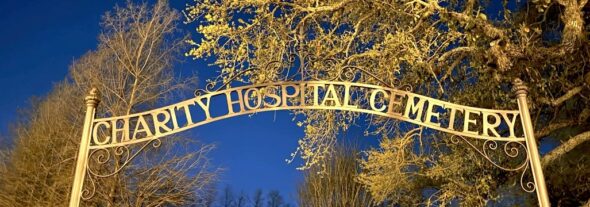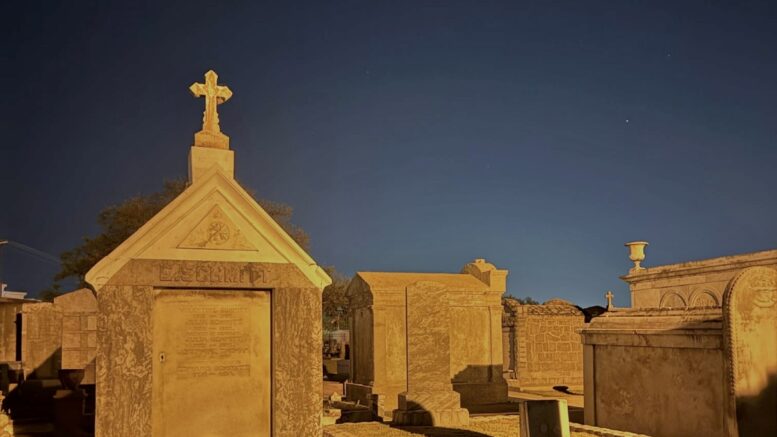By Abby Wahl
Over spring break this year, I had the pleasure of visiting New Orleans, Louisiana. I have been to the city before, but this time was different.
The people of New Orleans are no strangers to parties and celebrations; the city is called the “Big Easy” for its laid-back nature. When you enter New Orleans, you forget all your worries and let the good times roll.
This poses the question: how do the people of the city deal with grief and tragedy? Due to its geographical location, the city’s people have adapted to new practices of burying their loved ones and emphasizing celebrating their lives.
I took a cemetery tour at night on my last day there to find the answer to how the “Big Easy” goes about the big sleep. The relationship the people of New Orleans have with death is something we can all learn from.
My biggest takeaway from visiting the city and seeing all of these places is that everyone dies two deaths: one physical and another when their memory is forgotten.
While walking between the giant marble tombs, I felt a sense of caring coming from each refurbished marble slate, each vase of flowers, and each stuffed animal placed outside the tomb to guard it. Death is a terrifying, inevitable event, but approaching it with a sense of celebration of the person’s life makes all the difference.
Some parts of New Orleans are as deep as 10 feet below sea level, which makes burying bodies underground a bit tricky. High chances of flooding make for displacements of bodies and coffins underground. However, geographical concerns are not the only reason new burial practices take shape.
The city has a vast cultural history, with many different people influencing the food and architecture. From the French to the Spanish to the African and Caribbean, New Orleans has become a melting pot of various cultures.
As more people subsequently came to New Orleans, the need for cemeteries increased. This, in turn, was also caused by an epidemic of Yellow Fever, resulting in the deaths of over forty thousand people. The oldest cemetery in the city is St. Louis No. 1, originally built in 1789, following the large death toll.
Due to the prior Spanish influence, the custom of using vaults became increasingly popular as they protected bodies better than wooden coffins. At the turn of the century, the city would be sold to the French, and they would bring the concept of “oven tombs”, more commonly known as “fours.”
Following the greater economic prosperity in the 19th century, having an above-ground family tomb became a symbol of wealth. The tombs, built from brick, were reminiscent of Roman and Spanish design while also serving as a crematorium for the family. When a family member died, they were placed in the tomb.
Due to the year-round sweltering heat in the city, the body would eventually decompose and turn to ash. This would allow the whole family to be buried in a single tomb, conserving space in the city.
I initially visited St. Louis No.1 a year ago and was amazed by the attention to detail on the tombs, with Egyptian and Roman gods and symbols adorning the stone. The tombs in New Orleans are mostly on display above ground and show people like me who visit them how cared for someone can be after death and how grand their existence was.
While the burial practices are grandiose, demonstrating how well-kept a person’s resting place is after death, the celebration of life is even bigger. African American communities have brought the tradition of jazz funerals, which have become a staple in New Orleans.
The practice originated in the crux of the slave trade in the United States, making sure that the deceased are celebrated even in their death. The “first line” of the procession is the deceased’s family, and the jazz band, all playing as they march. The crowds of mourners and community members behind the band are called the “second line,” full of dancing and singing.
These events are significant to the communities, as they represent decades of tradition and the joy of living, rather than the inevitability of death.

Cemeteries also serve as a site for honoring disaster victims in New Orleans. One of my most impactful experiences was visiting the Charity Hospital Cemetery. The cemetery houses a memorial to the unidentified victims of the flooding following Hurricane Katrina in 2005.
The memorial, made from a strong black marble with greenery and benches, is positioned to look like the eye of a hurricane from a bird’s eye view. This is another example of oven tombs being used due to the multitudes of casualties left after a tragedy. The victims in these tombs could not be identified, so the site serves to preserve their memory after the devastating catastrophe.
Coming back from the city, I feel the need to share the care and attention the people of New Orleans pay to their deceased loved ones. Although the city is known for its more macabre side, there is a heartwarming element to the continuous celebration of life.




Be the first to comment on "Bury Me Above Ground: What New Orleans Can Teach Us About Death"